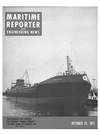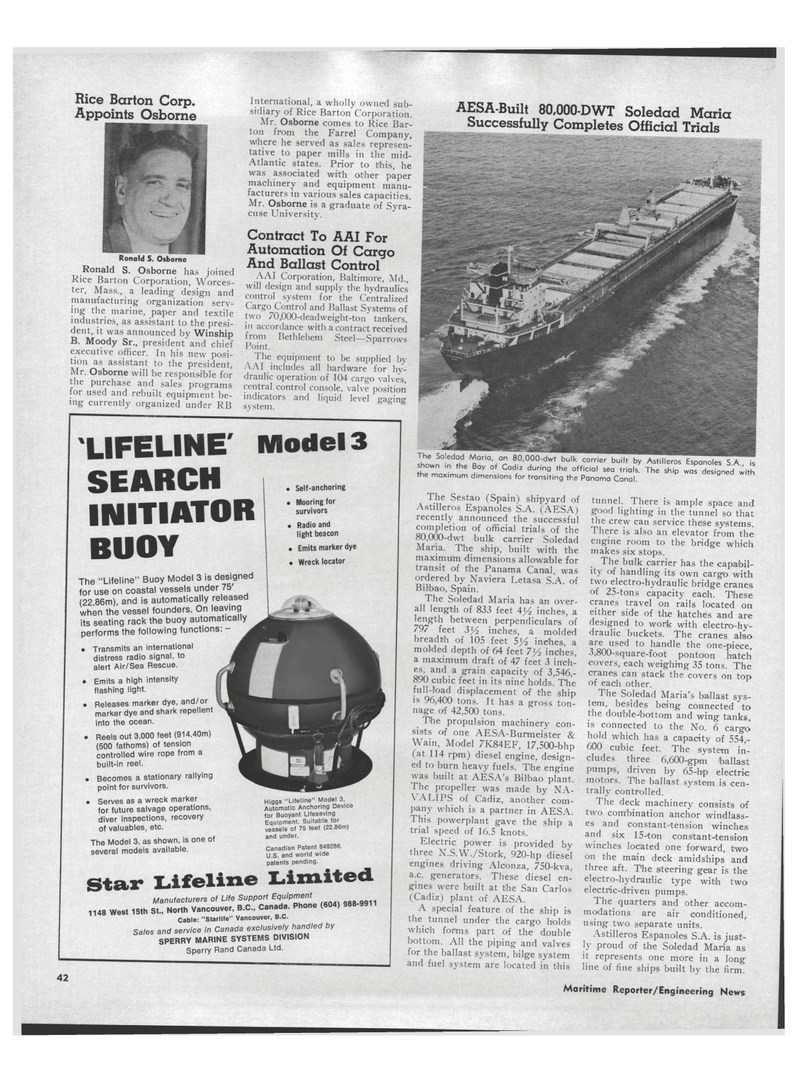
Page 38: of Maritime Reporter Magazine (October 15, 1971)
Read this page in Pdf, Flash or Html5 edition of October 15, 1971 Maritime Reporter Magazine
LIFELINE' Model 3
SEARCH
INITIATOR
RUOY . Self-anchoring • Mooring for survivors • Radio and light beacon • Emits marker dye • Wreck locator » Becomes a stationary rallying point for survivors. • Serves as a wreck marker for future salvage operations, diver inspections, recovery of valuables, etc.
The Model 3, as shown, is one of several models available.
Higgs "Lifeline" Model 3,
Automatic Anchoring Device for Buoyant Lifesaving
Equipment. Suitable for vessels of 75 feet (22.86m) and under.
Canadian Patent 849286.
U.S. and world wide patents pending.
Star Lifeline Limited.
Manufacturers of Life Support Equipment 1148 West 15th St., North Vancouver, B.C., Canada. Phone (604) 988-9911
Cable: "Starlife" Vancouver, B.C.
Sales and service in Canada exclusively handled by
SPERRY MARINE SYSTEMS DIVISION
Sperry Rand Canada Ltd.
AESA-Built 80,000-DWT Soledad Maria
Successfully Completes Official Trials
The "Lifeline" Buoy Model 3 is designed for use on coastal vessels under 75' (22 86m) and is automatically released when the vessel founders. On leaving its seating rack the buoy automatically performs the following functions: - > Transmits an international distress radio signal, to alert Air/Sea Rescue.
Emits a high intensity flashing light.
Releases marker dye, and/or marker dye and shark repellent into the ocean.
Reels out 3,000 feet (914.40m) (500 fathoms) of tension controlled wire rope from a built-in reel.
Ronald S. Osborne
Ronald S. Osborne has joined
Rice Barton Corporation, Worces- ter, Mass., a leading design and manufacturing organization serv- ing the marine, paper and textile industries, as assistant to the presi- dent, it was announced by Winship
B. Moody Sr., president and chief executive officer. In his new posi- tion as assistant to the president,
Mr. Osborne will be responsible for the purchase and sales programs for used and rebuilt equipment be- ing currently organized under RB
Contract To AAI For
Automation Of Cargo
And Ballast Control
AAI Corporation, Baltimore, Md., will design and supply the hydraulics control system for the Centralized
Cargo Control and Ballast Systems of two 70,000-deadweight-ton tankers, in accordance with a contract received from Bethlehem Steel—Sparrows
Point.
The equipment to be supplied by
AAI includes all hardware for hy- draulic operation of 104 cargo valves, central control console, valve position indicators and liquid level gaging system. ' """'"J- an ou,uuu-awt bulk carrier built by Astilleros Espanoles SA i« the0^;" the,Bay °f CadJZ duHng the °fficial The ship was desfgned with the maximum dimensions for transiting the Panama Canal.
The Sestao (Spain) shipyard of
Astilleros Espanoles S.A. (AESA) recently announced the successful completion of official trials of the 80,000-dwt bulk carrier Soledad
Maria. The ship, built with the maximum dimensions allowable for transit of the Panama Canal, was ordered by Naviera Letasa S.A. of
Bilbao, Spain.
The Soledad Maria has an over- all length of 833 feet Al/2 inches, a length between perpendiculars of 797 feet 2>y2 inches, a molded breadth of 105 feet 5l/2 inches, a molded depth of 64 feet 7^4 inches, a maximum draft of 47 feet 3 inch- es, and a grain capacity of 3,546,- 890 cubic feet in its nine holds. The full-load displacement of the ship is 96,400 tons. It has a gross ton- nage of 42,500 tons.
The propulsion machinery con- sists of one AESA-Burmeister &
Wain, Model 7K84EF, 17,500-bhp (at 114 rpm) diesel engine, design- ed to burn heavy fuels. The engine was built at AESA's Bilbao plant.
The propeller was made by NA-
VALIPS of Cadiz, another com- pany which is a partner in AESA.
This powerplant gave the ship a trial speed of 16.5 knots.
Electric power is provided by three N.S.W./Stork, 920-hp diesel engines driving Alconza, 750^kva, a.c. generators. These diesel en- gines were built at the San Carlos (Cadiz) plant of AESA.
A special feature of the ship is the tunnel under the cargo holds which forms part of the double bottom. All the piping and valves for the ballast system, bilge system and fuel system are located in this tunnel. There is ample space and good lighting in the tunnel so that the crew can service these systems.
There is also an elevator from the engine room to the bridge which makes six stops.
The bulk carrier has the capabil- ity of handling its own cargo with two electro-hydraulic bridge cranes of 25-tons capacity each. These cranes travel on rails located on either side of the hatches and are designed to work with electro-hy- draulic buckets. The cranes also are used to handle the one-piece, 3,800-square-foot pontoon hatch covers, each weighing 35 tons. The cranes can stack the covers on top of each other.
The Soledad Maria's ballast sys- tem, besides being connected to the double-bottom and wing tanks, is connected to the No. 6 cargo hold which has a capacity of 554,- 600 cubic feet. The system in- cludes three 6,600-gpm ballast pumps, driven by 65-hp electric motors. The ballast system is cen- trally controlled.
The deck machinery consists of two combination anchor windlass- es and constant-tension winches and six 15-ton cons'tant-tension winches located one forward, two on the main deck amidships and three aft. The steering gear is the electro4iydraulic type with two electric-driven pumps.
The quarters and other accom- modations are air conditioned, using two separate units.
Astilleros Espanoles S.A. is just- ly proud of the Soledad Maria as it represents one more in a long line of fine ships built by the firm.
Rice Barton Corp.
Appoints Osborne
International, a wholly owned sub- sidiary of Rice Barton Corporation.
Mr. Osborne comes to Rice Bar- ton from the Farrel Company, where he served as sales represen- tative to paper mills in the mid-
Atlantic states. Prior to this, he was associated with other paper machinery and equipment manu- facturers in various sales capacities.
Mr. Osborne is a graduate of Syra- cuse University. 40 Maritime Reporter/Engineering News

 37
37

 39
39
